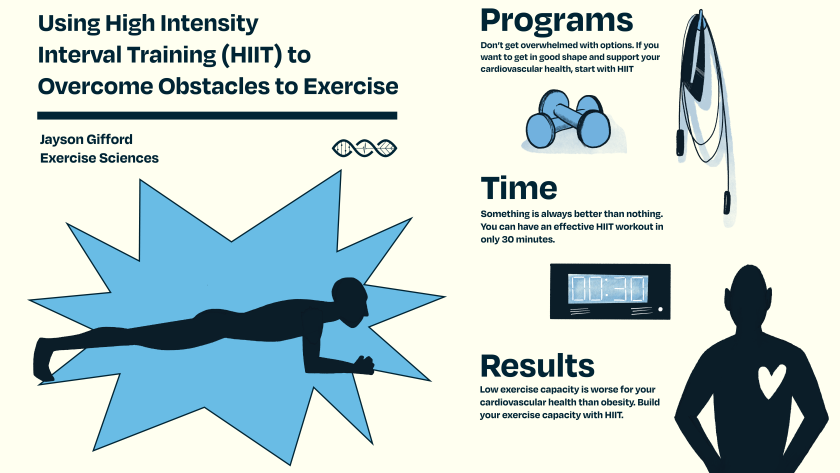There are many obstacles that keep us from working out regularly. Three common hindrances include finding a suitable program, lacking time, and craving results. Exercise Sciences professor Jayson Gifford’s research lab is scientifically addressing these obstacles. Gifford proposes High Intensity Interval Training (HIIT) as a solution to these three most common obstacles.
Disclaimer- Individuals with a history of cardiovascular disease, metabolic disease or other conditions should consult their doctor before participating in a vigorous exercise program.

Finding a suitable program
Problem: From in-person classes, YouTube videos, gyms, apps, social media posts, etc., there is an overwhelming number of exercise programs to choose from. If you don’t know where to start, how do you begin?
Solution: Some universal fitness goals include getting in good shape and reducing risk of cardiovascular disease, and (HIIT) can address those goals quite efficiently.
Before starting a HIIT program, determine your maximum aerobic capacity by exercising at a light intensity for three minutes then raising the intensity every minute until you can no longer exercise. The final intensity you complete for a whole minute will be your maximum aerobic capacity.
The 4x4 Norwegian model is a great way to start HIIT. The protocol switches from light intensity to high intensity exercise every 4 minutes. First, start with a four-minute warmup at approximately 20% of your maximum aerobic capacity. After the four-minute warm-up, do a four-minute, high-intensity interval at 80% of your maximum aerobic capacity, then recover at 20% of your maximum aerobic capacity for 4 minutes. Repeat this pattern four times and you have yourself a workout that improves cardiovascular health and aerobic fitness more than simply going for a long jog at moderate pace.
Time
Problem: It’s hard to invest the time needed to exercise in a fast-paced world. A single workout could take a couple of hours if you consider the time needed to get ready, commute to a gym, work out, and shower. It may feel like you need to work out for a significant period of time for it to be worth it, but that’s not true!
Solution: When it comes to exercise, let’s live by the saying “something is better than nothing.” HIIT is an exercise program that can be effective in short intervals of time because the program tests your cardiovascular health at a high intensity. Research indicates that the biggest impact exercise has on your health occurs when you transition away from inactivity. We must find the patience to exercise, even if it’s only for 20 minutes.
Results
Problem: Who doesn't want to look in the mirror after a workout and suddenly see a six-pack? Results are the most rewarding element of exercise, but the best outcomes aren’t aesthetic. Results tend to focus on rock-hard abs and losing weight instead of the long-term, inward benefits.
Solution: We have to shift our minds away from results in order to create healthy lifelong relationships with exercise. Focus on exercising in order to improve basic physical capabilities, cardiovascular health, insulin resistance, and mental health. Several studies suggest that having a low exercise capacity is worse for your cardiovascular health than obesity, and HIIT is a great way to start building your exercise capacity. Working out is so much more than achieving your dream body, it’s about supporting your health.
If HIIT doesn’t work for you, try something else! You’ll eventually find the right fit, and your body will always thank you for moving a little.